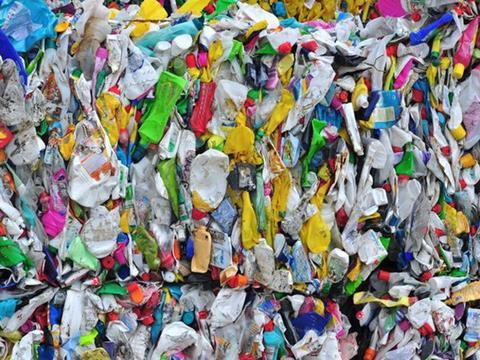
Mark Victory, Senior Editor Recycling at ICIS, explores the reasons behind shortages in recycled materials, and what steps could be taken for flexibles to bridge the gap.
LDPE is the most widely used plastic in packaging applications globally, and the development of further mechanical recycling volumes that can be reused by the packaging market essential.
There is currently around 700,000-800,000 tonnes/year of post-consumer rigid LDPE collected in Europe each year, according to market estimates. If every single tonne of this was used in the packaging industry with no wastage, this would still only be sufficient to replace approximately 15% of European LDPE packaging demand, based on figures from ICIS’ supply/demand database.
However, at least 25% of input material is wasted during the recycling process due to contamination on process losses, and this figure can rise to as high as 50%. Coupled with this approximately 10% of this is natural material, meaning that even if collection widened significantly beyond France, availability would remain too limited to meet fast-moving consumer goods (FMCG) targets which are typically for 25-50% recycled content by 2025.
Rapid growth in the collection and recycling of flexibles could help partially offset the current shortage of sufficient mechanically recycled material to meet packaging sector demand, particularly for the recycled low-density polyethylene (R-LDPE) chain.
Flexibles - defined as material with a thickness of less than 0.25mm - typically comprise such plastic waste as cling film, lids from ready meals and refuse bags. Theynow stand as one of the most profitable and attractive parts of the R-LDPE chain for waste collectors and recyclers, where previously material had been largely discarded. This is driving rapid development of the sector.
For R-LDPE this is because flexible material provides one of the few sources of material that can be widely adopted by the packaging sector, where sustainability pressure is most intense.
Outside of flexibles and some small quantities of post-industrial derived material, R-LDPE suitable for use in primary packaging is predominantly limited to material from France.
This is because across most of Europe, rigid R-LDPE is produced from mixed-coloured post-consumer bales and the natural fragment - limited to around 10% of an average bale - used to produce honeycomb natural pellets (pellets with an amber-tinge) which can only be used in secondary packaging applications. The main end-use for this grade remains non-packaging applications.
In France, 'eco-modulation' fees introduced by the French government have subsidised the sorting and separation of bales at point of collection - which had previously been deemed prohibitively expensive. This has led to natural bales being sold in France, which can then be used to produced natural transparent pellets suitable for use in primary packaging applications.
Nevertheless, there is a shortage of current sorting and collection capacity in France compared to the demand coming from the European packaging sector.
Underlying buying interest from the packaging industry has been growing in recent years due to the ongoing backlash against single-use plastics, mounting consumer and regulatory pressure on packaging firms, and rising sustainability targets among Fast Moving Consumer Goods (FMCG) producers.

The net result has been that rigid natural bales are currently trading at more than four times the price of mixed-coloured, and rigid natural transparent pellet ex-works NWE (northwest Europe) at more than €200/tonne above rigid natural honeycomb ex-works NWE pellets.
Although some reprocessers have been producing material from flexibles for a number of years, the current market size stands at less than 100,000 tonnes/year, according to market estimates.
Many local authorities still do not allow flexibles into recycling streams, and many waste managers do not yet have the capability to process this material. Instead, typically flexible material is included in what are colloquially referred to as ‘MERF’ bales - which are bales of mixed plastic material that has been rejected by a municipal recycling facility for reprocessing or sorting and separating.
Nevertheless, separated collection systems are becoming increasingly common, particularly in the UK where major supermarket chains Sainsbury’s and Tesco have introduced flexible R-PE and R-PP collection points within the past two years.
Post-consumer material is typically sold on a mixed-coloured basis and material reprocessed from it is predominantly used for bin bag production. However, it is the post-commercial sector that could lead to a rapid increase in the availability of material suitable for use in primary packaging applications.
Post-commercial bales are made up of pre-consumer waste from the retail industry, which is typically used in the distribution of products to point-of-sale for applications such as wrapping pallets for transport.
As a result, this material is typically clear and rarely comes into direct contact with the product itself, meaning that it typically does not become odourised and contamination is limited. Contamination levels are typically kept below 2%, and it can be used as a feedstock to create near virgin-like mechanically recycled material (although as with all mechanically recycled materials, it does suffer from tensile strength degradation with each cycle).
Pellets produced from flexible bales are typically broken down in to three grades from least to most transparent, natural honeycomb, natural translucent, and natural transparent.
The spread between feedstock post-commercial natural flexible bales and transparent pellets - which are the most desirable grade from the packaging sector - is currently €950-1,050/tonne on average in Europe. This compares favourably, for producers, with a spread of €700-800/tonne between rigid natural post-consumer bales and rigid natural transparent pellets.
With regulation against single-use plastics continuing to intensify, and public pressure at an all-time high, underlying demand from packaging is expected to continue to sharply increase over the next few years.
The bulk of R-LDPE currently produced in Europe is not suitable for use in packaging. Scaling-up the collection of flexibles could change that.
Mark Victory and two of his colleagues at ICIS recently joined us for a webinar on the current state of the recycled plastics market.Watch the on-demand webinar here!
















